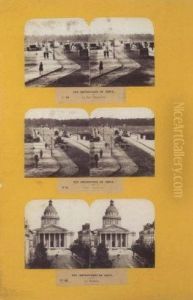Hippolyte Jouvin Paintings
Hippolyte Jouvin was a French photographer known for his work in the mid-19th century, a period that witnessed the burgeoning of photography as an art form and a means of documentation. Born in 1825, Jouvin was part of a generation that saw the transition from painting and engraving as the primary visual recording mediums to the innovative process of capturing images through light and chemistry.
After learning the photographic process, which was still relatively new and developing at the time, Jouvin began his career in photography. He was particularly recognized for his cityscapes and landscapes, capturing the evolving face of urban Europe. His works are notable for their clarity, composition, and for being an early example of travel photography, as he often depicted scenes from various countries including France, Italy, and Switzerland.
Jouvin's photography also provides a historical record of 19th-century life, offering insights into the architecture, urban planning, and social conditions of the era. He was adept at using the collodion process, which was the leading method of the time, allowing for relatively short exposure times and creating clear, detailed images that were well-suited for his subject matter.
Despite his contributions to the field of photography, Hippolyte Jouvin is not as widely remembered as some of his contemporaries, such as Gustave Le Gray or Nadar. However, his work remains significant for its artistic and documentary value. His photographs can be found in the collections of various museums and institutions that specialize in the history of photography.
Jouvin continued to work and contribute to the field until his death in 1889. His legacy is that of a pioneer in the early days of photography, capturing a world that was rapidly changing and leaving a visual record for future generations to appreciate.
